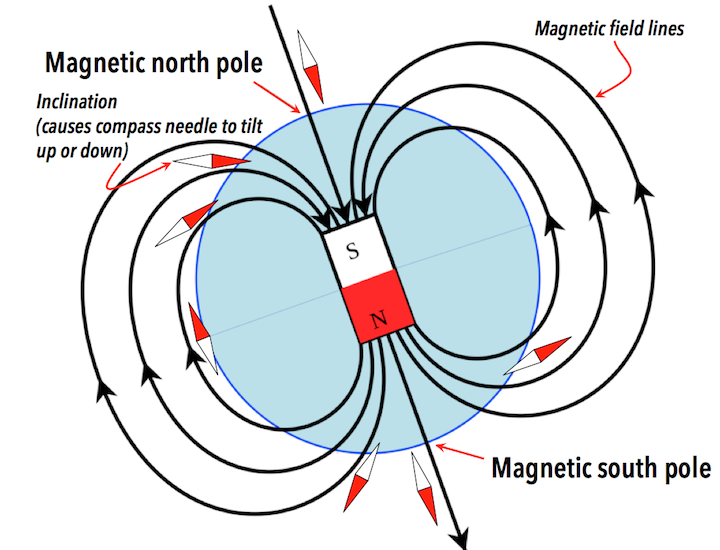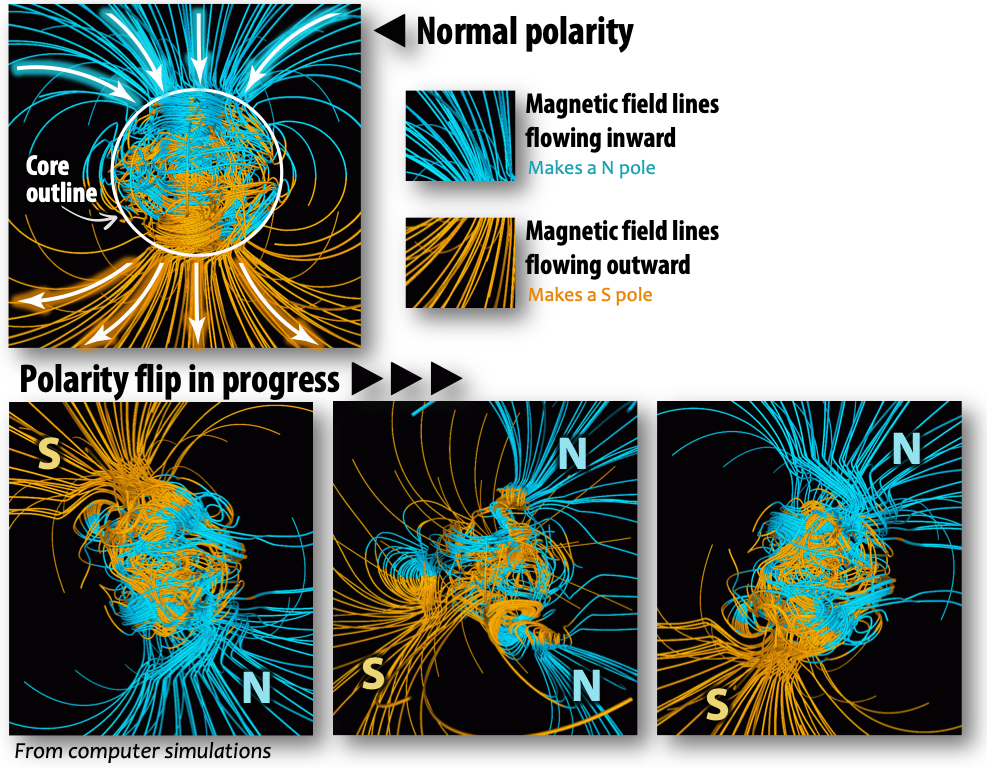3.4 Earth’s Magnetic Field
Similar to the mantle, Earth’s liquid outer core convects because it’s heated from beneath by the inner core. What’s different is that because it’s made of iron and conducts electricity (even when molten), the motion of the outer core generates a magnetic field.
Earth’s magnetic field is defined by north and south poles representing lines of magnetic force flowing into Earth in the northern hemisphere, and out of Earth in the southern hemisphere (Figure 3.14). Because of the shape of the field lines, the magnetic force is oriented at different angles to the surface in different locations. The tilt, or inclination of magnetic field lines is represented by the tilt of compass needles in Figure 3.14. At the north and south poles, the force is vertical. The force is horizontal at the equator. Everywhere in between, the magnetic force is at an intermediate angle to the surface.

Practice: Magnetic Inclination
Use Figure 3.14 as a guide to help you complete this exercise.
- Straight down- Quttinirpaaq National Park, Ellesmere Island. This is the current location of the .
- Down at a steep angle- Santa’s workshop on a specially-designed ice breaker anchored in the Arctic Ocean (the location of the .)
- Up at a steep angle- McMurdo Station, which is on the coast of Antarctica near the .
- Parallel to flat ground- Damba Island, Uganda, which straddles the .
Fill-in-the-blank options:
- geographic north pole
- south pole
- magnetic north pole
- equator
To check your answers, navigate to the below link to view the interactive version of this activity.
Polarity Reversals
Instability in Earth’s Magnetic Field
Earth’s magnetic field is generated mostly within the outer core by the convective movement of liquid iron, but although convection is continuous, the magnetic field is not stable. Periodically, the magnetic field decays, then re-estabilshes. When it does re-establish, the polarity may have reversed. In other words, your compass needle would point south rather than north.
Changes in Earth’s magnetic field have been studied using mathematical models that simulate convection in the outer core (Figure 3.15). Reversals happened spontaneously when the model was run to simulate a period of several hundred thousand years. Spontaneous reversals can happen because convection doesn’t occur in an orderly way, in spite of what the bar magnet analogy may suggest.

The solid inner core also convects, with many small-scale variations in convection patterns, but it does so more slowly than the liquid outer core. Yet Earth’s magnetic field is the sum of all of those variations—both inner and outer—and for a polarity reversal to “take,” a reversal must happen in the magnetic fields of both parts of the core. If the inner core weren’t solid, magnetic reversals would happen far more frequently.
How Often Do Polarity Reversals Happen?
Over the past 250 Ma, there have been hundreds of magnetic field reversals, and their timing has been anything but regular. The shortest ones that geologists have been able to identify lasted only a few thousand years, and the longest one was more than 30 million years, during the Cretaceous Period (Figure 3.16).

Concept Check: Polarity Reversals
Magnetic polarity reversals happen because:
- Earth flips over so that it’s geographic poles change place.
- A new pattern develops in how Earth’s core churns itself.
- Earth’s core switches to rotating in the opposite direction within Earth.
- Earth switches to rotating in the opposite direction on its axis.
To check your answers, navigate to the below link to view the interactive version of this activity.
References
British Geological Survey, Natural Environment Research Council (n.d.). Reversals: Magnetic flip. http://www.geomag.bgs.ac.uk/education/reversals.html
Glatzmaier, G. A. (n.d.) The geodynamo. https://websites.pmc.ucsc.edu/~glatz/geodynamo.html
Glatzmaier, G. A., & Roberts, P.H. (1995). A three-dimensional self-consistent computer simulation of a geomagnetic field reversal. Nature, 377, 203-209.

